Volcano DefinitionVolcanoes are one of the most awe-inspiring natural phenomena on Earth. They are majestic mountains that can spew molten rock and ash into the sky, often with devastating consequences. There are volcanoes in many regions across the world, which have significantly shaped the planet's surface and affected the climate. 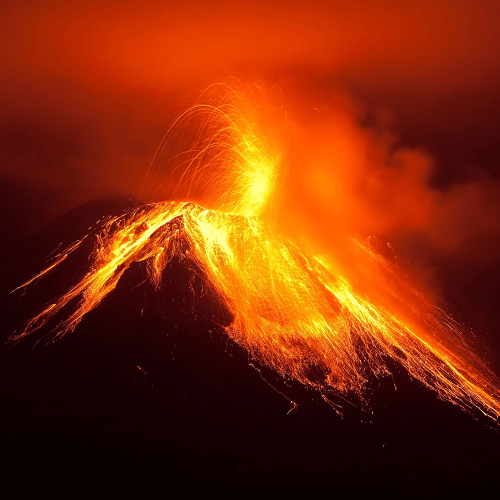
What is Volcano?A volcano is a kind of geological landform created by the eruption of magma or molten rock from the Earth's crust. In essence, it is an opening in the Earth's surface through which gas, ash, and magma may escape. Volcanoes can take many different forms, including steep, cone-shaped mountains and low, broad structures with gentle slopes. They can be found all over the world and have played a significant role in shaping the Earth's surface and influencing the global climate. Volcanoes can be both beautiful and dangerous, attracting tourists and scientists but also posing risks to human populations and the environment. Several types of volcanic eruptions can result in magma reaching the Earth's surface, depending on the viscosity of the magma and the quantity of gas trapped inside it. Some eruptions are relatively calm, producing slow-moving lava flows that can create new land and add to the size of the volcano over time. Other eruptions can be explosive, sending ash and rock into the sky and causing significant damage to the surrounding area. Volcanoes can have a significant impact on the environment and the global climate. When a volcano erupts, it can release large amounts of sulfur dioxide and other gases into the atmosphere, which can combine with water vapor to form sulfuric acid aerosols. These aerosols have the ability to reflect sunlight back into space, which cools the climate on Earth. Volcanic eruptions can also have more immediate and direct effects on the environment and human populations. Lava flows and pyroclastic flows can destroy buildings and infrastructure, while ash and tephra can disrupt air travel and cause respiratory problems for people and animals. Volcanoes continue to attract scientists and visitors alike despite the dangers and difficulties they provide. Volcanoes offer a glimpse into the Earth's internal processes, and they provide valuable insights into the history and formation of our planet. As such, they remain an important area of study for geologists, volcanologists, and other scientists who seek to better understand the natural world around us. Types of VolcanoThere are several types of volcanoes, such as: Shield Volcanoes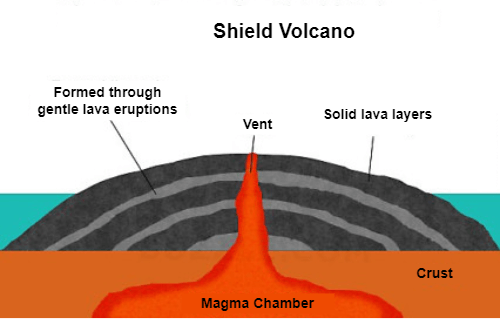
Shield volcanoes are a type of volcanoes that are characterized by their broad, gentle slopes and relatively low, flat profiles. They are typically formed by the eruption of highly fluid lava, which flows out of the volcano and spreads out over a large area, creating a shield-like shape. Shield volcanoes are the largest volcanoes on Earth, and they can be found in many different parts of the world. The lava that erupts from shield volcanoes is typically basaltic in composition, which means that it is low in viscosity and flows easily. As a result, the lava can travel long distances from the vent of the volcano, creating vast fields of lava flows that can cover hundreds or even thousands of square kilometers. Because the lava flows are so fluid, they tend to be relatively low in explosive activity, although there can still be occasional eruptions of gas and ash. One of the most famous shield volcanoes in the world is Mauna Loa, which is located on the Big Island of Hawaii. Mauna Loa is one of the largest volcanoes on Earth, rising over 4,000 meters above sea level and extending nearly 100 kilometers from its base. It has erupted many times in the past, with the most recent eruption occurring in 1984. Despite its size and frequent eruptions, Mauna Loa is considered to be a relatively gentle volcano, with lava flows that are slow-moving and predictable. Another well-known shield volcano is Iceland's Eyjafjallajökull, which erupted in 2010 and caused widespread disruption to air travel in Europe. Despite its relatively small size compared to other shield volcanoes, Eyjafjallajökull's eruption was particularly explosive, producing a large ash cloud that disrupted air travel across much of Europe for several weeks. Stratovolcanoes or Composite Volcanoes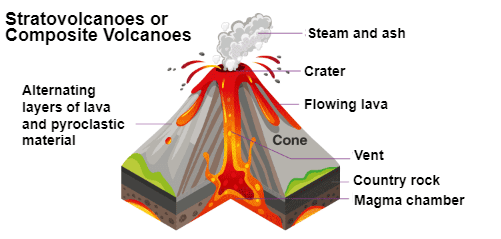
These are the type of volcanoes that are characterized by their steep, conical shape and explosive eruptions. They are formed by the accumulation of layers of volcanic ash, pumice, and lava flows that build up over time, creating a tall, symmetrical mountain. Composite volcanoes are found in many parts of the world, including the Pacific Ring of Fire, where they are the most common type of volcano. The eruptions of composite volcanoes are typically highly explosive and can produce a wide range of volcanic hazards, including pyroclastic flows, lahars, and volcanic ash. Pyroclastic flows are fast-moving, highly destructive currents of hot gas and volcanic debris that can race down the slopes of the volcano at speeds of up to 700 kilometers per hour. Lahars are fast-moving, muddy flows of volcanic debris that can travel long distances from the volcano and can be highly destructive to communities and infrastructure in their path. Volcanic ash, meanwhile, can travel thousands of kilometers from the volcano and can pose a significant risk to aviation, agriculture, and human health. One of the most famous composite volcanoes in the world is Mount St. Helens, which is located in the state of Washington in the United States. Mount St. Helens erupted in 1980 in a highly explosive eruption that killed 57 people and caused extensive damage to the surrounding area. The eruption of Mount St. Helens was caused by a buildup of gas and pressure within the volcano, which eventually led to the collapse of the volcano's north flank and the release of a massive pyroclastic flow. Another well-known composite volcano is Mount Fuji, which is located on the island of Honshu in Japan. Mount Fuji is an active volcano that last erupted in 1707, and it is considered to be a symbol of Japan and an important cultural and spiritual site. Despite its status as an active volcano, Mount Fuji is closely monitored by scientists and is considered to be a relatively low-risk volcano. Cinder Cones Volcanoes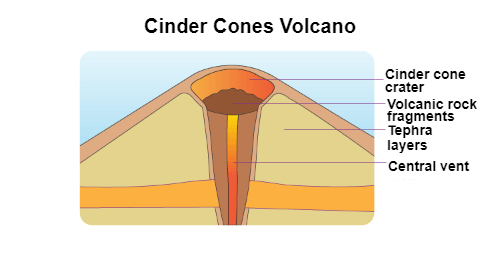
Cinder cones, also known as scoria cones, are a type of volcanoes that are characterized by their steep, conical shape and relatively small size. They are typically formed by the eruption of small quantities of gas-rich, basaltic lava that is ejected from the volcano in the form of cinders and ash. These cinders and ash accumulate around the vent of the volcano, building up over time to create a cone-shaped mountain. Cinder cones are the most common type of volcano in the world and are found in many different parts of the world, including the United States, Mexico, and Italy. They are typically much smaller than composite volcanoes, with heights ranging from tens to hundreds of meters. The eruptions of cinder cones are typically relatively mild compared to other types of volcanoes, with lava flows that are slow-moving and less explosive. However, cinder cones can still pose risks to people and infrastructure in the area, particularly if they are located near populated areas or important infrastructure. One of the most famous cinder cones in the world is Paricutin, which is located in the state of Michoacan in Mexico. Paricutin began as a small fissure in a farmer's cornfield in 1943 and quickly grew into a full-fledged volcano, eventually reaching a height of over 400 meters. The eruption of Paricutin lasted for nearly a decade, and the volcano has since become an important site for scientific study and tourism. Another well-known cinder cone is Sunset Crater, which is located in Arizona in the United States. Sunset Crater erupted sometime between 1040 and 1100 AD, and its eruption is thought to have had a significant impact on the local environment and indigenous populations. Today, Sunset Crater is a popular tourist destination and is also an important site for scientific study. Calderas Volcanoes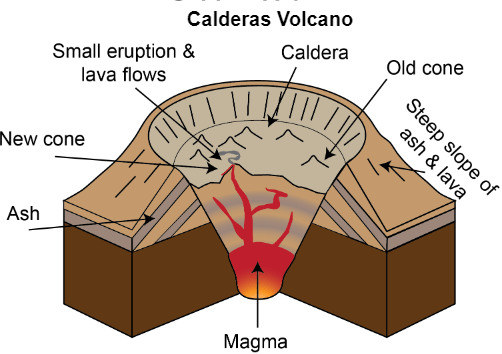
Calderas are large, basin-shaped depressions that get formed when a volcano erupts and empties its magma chamber, causing the ground above to collapse. They are typically much larger than the original volcano and can range in size from a few kilometers to over 50 kilometers in diameter. Calderas are found in many parts of the world and can be formed by a variety of volcanic processes. One of the most famous calderas in the world is Yellowstone Caldera, which is located in Yellowstone National Park in the United States. Yellowstone Caldera is one of the largest volcanic systems in the world and is thought to have last erupted around 640,000 years ago. The eruption of Yellowstone Caldera was one of the most powerful volcanic events in recorded history and is thought to have had a significant impact on the global climate. Another well-known caldera is Crater Lake Caldera, which is located in Oregon in the United States. Crater Lake Caldera was formed by the eruption of Mount Mazama over 7,000 years ago and is now filled with water, creating one of the deepest lakes in the world. Crater Lake is an important site for scientific study and is also a popular tourist destination. Calderas can be formed by a variety of volcanic processes, including explosive eruptions, lava dome collapses, and magma chamber collapses. The formation of a caldera can have significant impacts on the local environment and can even affect the global climate if the eruption is large enough. Calderas are closely monitored by scientists and local authorities in order to help prevent or mitigate the impacts of future eruptions. In addition to their scientific importance, calderas are also important cultural and spiritual sites in many parts of the world. They have been revered and studied by indigenous populations for centuries and continue to play an important role in many cultural practices and beliefs. Fissure Volcanoes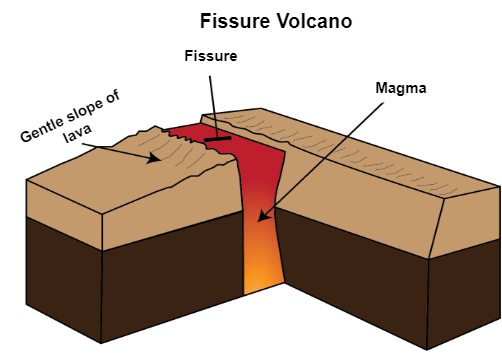
Fissure volcanoes are a type of volcanoes that are characterized by long, narrow cracks or fissures in the Earth's crust, through which magma can be extruded. They are also known as fissure vents or linear volcanoes and are typically found in areas of tectonic activity, such as rift zones or mid-ocean ridges. Fissure volcanoes are typically less explosive than other types of volcanoes, such as stratovolcanoes or shield volcanoes, and are characterized by the eruption of relatively fluid lava flows that can travel great distances from the fissure vent. These lava flows can cover vast areas of land, creating large basalt plateaus or lava fields. One of the most famous examples of a fissure volcano is the eruption of Laki in Iceland in 1783. This eruption lasted for eight months and produced one of the largest lava flows in recorded history, covering an area of over 500 square kilometers. The eruption also released huge amounts of sulfur dioxide into the atmosphere, causing a cooling effect on the Earth's climate that lasted for several years. Fissure volcanoes can pose significant risks to people and infrastructure in the area, particularly if they are located near populated areas or important infrastructure. However, they also offer important opportunities for scientific study and can help us better understand the processes that shape our planet. ConclusionIn conclusion, volcanoes are fascinating geological features that have shaped the Earth's surface and influenced the global climate for millions of years. While they can be beautiful and attract tourists and scientists, volcanoes also pose significant risks to human populations and the environment. It is important to understand the different types of volcanoes and their behavior in order to better prepare for potential hazards and mitigate their impacts. Despite the potential risks, volcanoes are a reminder of the incredible power and beauty of nature, and studying them can provide valuable insights into the history and workings of our planet.
Next TopicCongestive heart failure definition
|
 For Videos Join Our Youtube Channel: Join Now
For Videos Join Our Youtube Channel: Join Now
Feedback
- Send your Feedback to [email protected]
Help Others, Please Share










